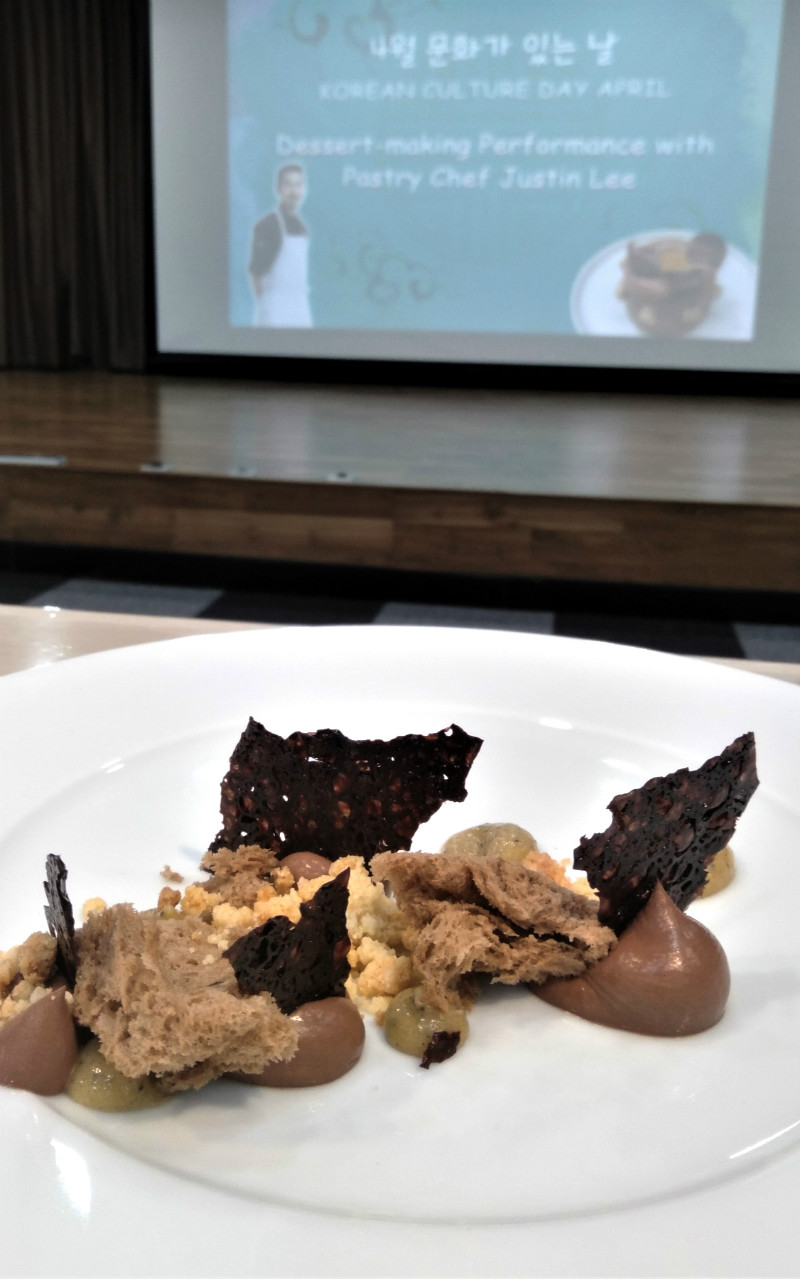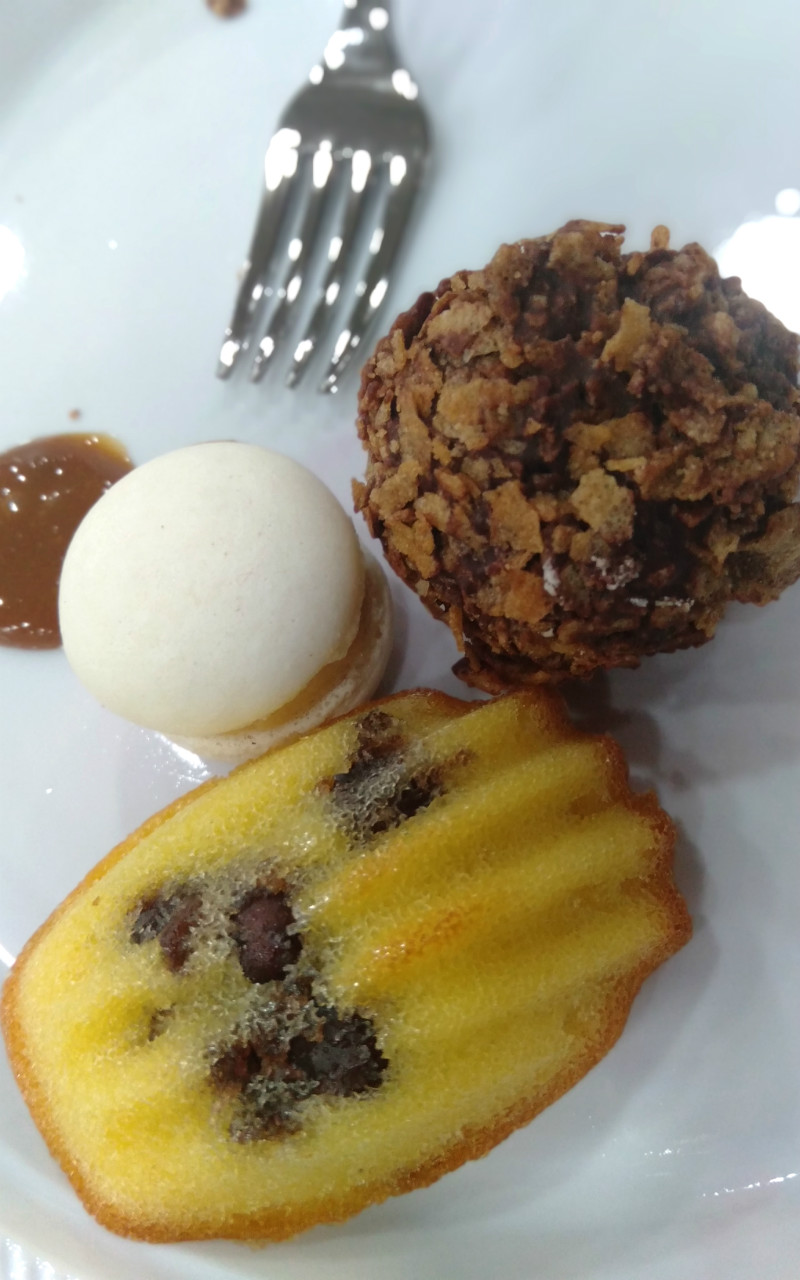View this article in another language
- 한국어
- English
- 日本語
- 中文
- العربية
- Español
- Français
- Deutsch
- Pусский
- Tiếng Việt
- Indonesian
By Honorary Reporter Magdalena Krisnawati from Indonesia
Photos = Magdalena Krisnawati

A fragrant aroma arises from the pastry being baked in the oven. The name of the item is hodugwaja (walnut confectionary) Madelaine made by Justin Lee, a Korean chef who has worked all over the world.
A mixture of flour, sugar, butter, boiled red beans and walnuts create the scrumptious scent. The pastry, Lee said, is a popular street food in Korea that is a dessert with a crunchy, sweet and savory taste with a combination of red bean and walnut flavors. "It smells good and it’s yummy too," a person who sat beside me said as she tried Lee's creation at the Korean Cultural Center (KCC) in Jakarta, where the chef demonstrated his four specialties of Korean desserts.
Lee said, "It's called a Korean dessert because the basic ingredients are often used in Korean food, but I made them with European techniques."
The KCC invited him to introduce a variety of Korean desserts for the monthly event Korean Culture Day, which debuted in April this year, under the title "Dessert-making Performance with Pastry Chef Justin Lee.” Lee was in Bali to participate in the Ubud Food Festival and at the dessert-making event, he attracted not only Indonesians but also ethnic Korean residents of the Indonesian capital.

In addition to hodugwaja Madelaine, the chef, with his relaxed and communicative style with the audience, made two other desserts: misugaru macaron, a small, white dessert with assorted grain powder as its basic ingredient, and a chestnut chocolate ball with crunch called Indonesian yullan.
His final selection for the event was the main dessert barley Bali, which earned its name because of the chocolate used from Bali. He showed a chocolate package with the word "Bali" written on it.
Other basic ingredients for this dessert were barley flour derived from grains from a wheat plant and pasta sauce made from fermented soybean to produce a sweet and salty taste.
"In Korea, this pasta is called doenjang (soybean paste), but to make barley Bali, I added caramel to the pasta so that it became doenjang caramel," he said.
All the ingredients had ginger powder added and were mixed with the infuse technique so that the mixture looked like cream. After being baked in the oven, the snack's texture was like that of a sponge. Lee arranged and decorated the dessert artistically on a plate with chocolate and pasta with mixed mango, banana and gel. As a pastry chef, he said he has to master the aesthetics of serving the dessert to ensure an attractive appearance that makes it appetizing in addition to good taste.

Barley Bali is made from 68% Bali chocolate sorbet, barley-infused Bali Namelaka cream, passion mango-banana gel, ginger, crumble and doenjang caramel.
Having worked as a chef for 10 years, Lee has focused on pastry for the past seven. He also has seven branches of his JL Dessert Bar, including one in the Muslim area of the city's Itaewon district.
When I asked him what he thinks of first when he wants to make an original dessert, he said he always considers seasonal fruit, adding, "And I choose fruit to match my arrangement of Valrhona chocolate, and look for the fruit and chocolate that matches well with it." Lee also has his own philosophy as a chef. "For me, I was a savory chef so I know what seasonal ingredients are, not only fruit. I want to use both sides of ingredients for my desserts…"
"And I want to be a bridge linking savory and pastry chefs."
The chef also said he was happy to share his dessert-making experience with audiences in Indonesia. “It was such a special event for me to use many Korean ingredients to make desserts in Bali and Jakarta," he said.
chaey0726@korea.kr
*This article is written by a Korea.net Honorary Reporter. Our group of Honorary Reporters are from all around the world, and they share with Korea.net their love and passion for all things Korean.
Photos = Magdalena Krisnawati

A fragrant aroma arises from the pastry being baked in the oven. The name of the item is hodugwaja (walnut confectionary) Madelaine made by Justin Lee, a Korean chef who has worked all over the world.
A mixture of flour, sugar, butter, boiled red beans and walnuts create the scrumptious scent. The pastry, Lee said, is a popular street food in Korea that is a dessert with a crunchy, sweet and savory taste with a combination of red bean and walnut flavors. "It smells good and it’s yummy too," a person who sat beside me said as she tried Lee's creation at the Korean Cultural Center (KCC) in Jakarta, where the chef demonstrated his four specialties of Korean desserts.
Lee said, "It's called a Korean dessert because the basic ingredients are often used in Korean food, but I made them with European techniques."
The KCC invited him to introduce a variety of Korean desserts for the monthly event Korean Culture Day, which debuted in April this year, under the title "Dessert-making Performance with Pastry Chef Justin Lee.” Lee was in Bali to participate in the Ubud Food Festival and at the dessert-making event, he attracted not only Indonesians but also ethnic Korean residents of the Indonesian capital.

In addition to hodugwaja Madelaine, the chef, with his relaxed and communicative style with the audience, made two other desserts: misugaru macaron, a small, white dessert with assorted grain powder as its basic ingredient, and a chestnut chocolate ball with crunch called Indonesian yullan.
His final selection for the event was the main dessert barley Bali, which earned its name because of the chocolate used from Bali. He showed a chocolate package with the word "Bali" written on it.
Other basic ingredients for this dessert were barley flour derived from grains from a wheat plant and pasta sauce made from fermented soybean to produce a sweet and salty taste.
"In Korea, this pasta is called doenjang (soybean paste), but to make barley Bali, I added caramel to the pasta so that it became doenjang caramel," he said.
All the ingredients had ginger powder added and were mixed with the infuse technique so that the mixture looked like cream. After being baked in the oven, the snack's texture was like that of a sponge. Lee arranged and decorated the dessert artistically on a plate with chocolate and pasta with mixed mango, banana and gel. As a pastry chef, he said he has to master the aesthetics of serving the dessert to ensure an attractive appearance that makes it appetizing in addition to good taste.

Barley Bali is made from 68% Bali chocolate sorbet, barley-infused Bali Namelaka cream, passion mango-banana gel, ginger, crumble and doenjang caramel.
Having worked as a chef for 10 years, Lee has focused on pastry for the past seven. He also has seven branches of his JL Dessert Bar, including one in the Muslim area of the city's Itaewon district.
When I asked him what he thinks of first when he wants to make an original dessert, he said he always considers seasonal fruit, adding, "And I choose fruit to match my arrangement of Valrhona chocolate, and look for the fruit and chocolate that matches well with it." Lee also has his own philosophy as a chef. "For me, I was a savory chef so I know what seasonal ingredients are, not only fruit. I want to use both sides of ingredients for my desserts…"
"And I want to be a bridge linking savory and pastry chefs."
The chef also said he was happy to share his dessert-making experience with audiences in Indonesia. “It was such a special event for me to use many Korean ingredients to make desserts in Bali and Jakarta," he said.
chaey0726@korea.kr
*This article is written by a Korea.net Honorary Reporter. Our group of Honorary Reporters are from all around the world, and they share with Korea.net their love and passion for all things Korean.